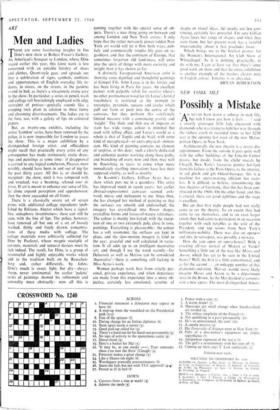Men and Ladies
ART THERE are some fascinating insights in Jim Dine's new show at Robert Fraser's Gallery. An American's bouquet to London, where Dine stayed earlier this year, this latest work is less concerned with an amiable fetishry of shoes and clothes, Quant-style gear, and spreads out into a celebration of signs, symbols, emblems and appurtenances of English everyday life in- doors, in stores, on the streets, in the gardens —and in bed, as there's a vivaciously erotic core to the show. In particular, a series in pencil, wash and collage (all bewitchingly employed with edgy restraint) of penises—genitalia sounds like a creeping rock plant in relation to these funny and charming divertissements. The ladies are to the fore, too, with a galaxy of lips on coloured papers.
But, as twenty-one exhibits, including the entire 'London' series, have been removed by the police, it is now impossible for London to assess the show. This is a major exhibition by a distinguished foreign artist; and officialdom might recall that practically every artist of any consequence has made strenuously erotic draw- ings and paintings at some time : if disapproval is carried to any logical conclusion, Picasso, most notably, .should have been in and out of jug for the past thirty years. All this is, or should be, marginal : the show, until it was tampered with and wrecked, was a beaming, relaxed tour de force. If art is meant to enhance our sense of life, let alone expand perception and apprehension, then the show succeeded on all fronts.
There is a classically severe set of screen prints with additional collage ingredients (pub- lished by Editions Alecto) which have a signal- like, semaphore inventiveness; these can still be seen, with the line of lips. The police, however, have removed all but one of a set of loosely washed, thinly and freely drawn, concentra- tions of these media with collage. The collage materials were arbitrarily collected for Dine by Paolozzi, whose magpie stockpile of cut-outs, materials and textural devices must be rich indeed. The result, for Dine, is a group of resourceful and highly enjoyable works which add to the tradition built on by Rauschen- berg and, rather differently, by Johns. Dine's touch is sweet, light, but dry—always sharp, never sentimental. An earlier 'palette' series of paintings showed his refinement and sensuality most abstractly : now all this is coming together with his special sense of ob- jects. There's a nice thing going on between and among London and New York artists: I only hope that the rather nervously power-ridden New York art world will let it flow both ways, pub- licly and commercially (studio life goes on re- gardless), and that the continent of Europe, that
sometimes forgotten old land-mass, will enter into the spirit of things with more curiosity and insight than it has shown so far.
A distinctly Europeanised American artist is showing some dignified and thoughtful paintings at Gimpel Fils. John Levee is in his forties and
has been living in Paris for years. An excellent painter with palpable relish for nzaWre (there's no other portmanteau word for it), Levee's formal vocabulary is restricted at the moment to rectangles, pyramids, squares and circles which pull out from or push into the centre of the canvases, but they perform this satisfyingly
limited measure with a convincing gravity and `weight.' The thick and thin use of impasto or stain has wide range, colour is minimal but used with telling effect, and Levee's world as a whole is that of Tapies and de St:tel. with some kind of metaphysical—or extra-physical—dimen- sion. His kind of painting contains no element of surprise, at this date: such a clearly dedicated and authentic painter working along those paths, and branching off every now and then, may well be flourishing in years to come when more immediately startling innovations have lost their supposed vitality, as well as novelty.
At Kasmin's Gallery, Gillian Ayres has a show which puts me in a quandary. This artist has improved much in recent years: her earlier abstract-expressionist canvases seemed awk- ward, messy and ineloquent to me. Since then, she has changed her method of painting so that the surfaces are smooth and undisturbed; the imagery has crystallised into flower shapes, crystalline forms and forces-of-nature references. The colour is mainly low-keyed, with the excep-
tion of one or two extremely pale, close in tone, paintings. Everything is pleasurable: the colour has a soft resonance, the surfaces are kept in place, and the slow-motion imagery is kind to the eye: graceful and well calculated in varia- tion. It all adds up to an intelligent decorative art; and though I use the word warmly—for Delacroix as well as Matisse can be considered
`decorative'—there is something still lacking in Miss Ayres's work.
Women perhaps work best from strictly per- sonal, private experience, and when departures are made from this experience into a more ob- jective, certainly less emotional, scrutiny of
shapes or visual ideas, the results are less con- vincing, certainly less powerful. I'm sure Gillian Ayres loves her range of shapes, and what they stem from, but her present work has a tasteful impersonality about it that precludes force.
Which brings me to the briefest pointer for the Women's International Art Club Show at Whitechapel. As it is nothing, practically, to do with me, I can at least say that there's some good work on show and that the entire exhibition is another example of the fresher, clearer note in English colour. Tonality is in abeyance.
BRYAN ROBERTSON


































 Previous page
Previous page